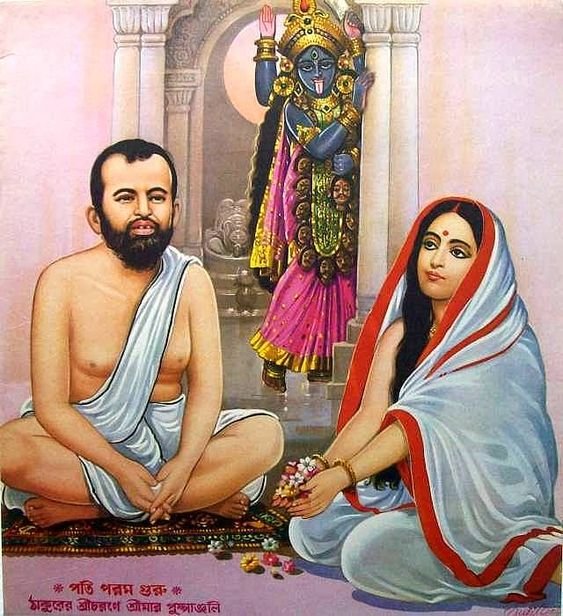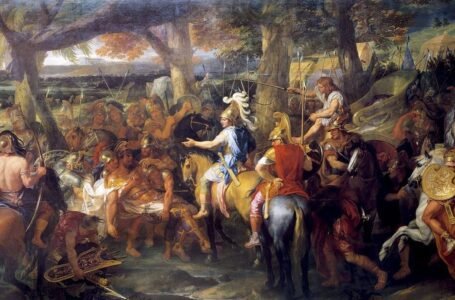Ramakrishna: The Mystic Saint of 19th Century India

Ramakrishna Paramahamsa, a revered saint and mystic, left an indelible mark on Hindu spirituality and religious pluralism. His life and teachings continue to inspire millions worldwide.Born in 1836 in Bengal, Ramakrishna exhibited spiritual inclinations from an early age. Despite minimal formal education, his quest for divine realisation led him to master various practices from different religious traditions.

Ramakrishna’s greatest achievement was his doctrine of the unity of all religions. He practised and validated the truth in various religious paths, including Islam and Christianity, alongside Hinduism. His legacy is carried forward by the Ramakrishna Order, founded by his chief disciple Swami Vivekananda. The Order promotes spiritual enlightenment and social service, embodying Ramakrishna’s vision of universal brotherhood. Ramakrishna’s spiritual journey was marked by profound experiences that shaped his philosophy. From a young age, he had moments of spiritual ecstasy, such as entering states of rapture at the sight of natural beauty or losing consciousness while embodying divine roles in plays.
As a priest at the Dakshineswar Kali Temple, his intense devotional practices led to various spiritual visions. He experienced direct encounters with divine figures from different faiths, affirming his belief that all religions lead to the same ultimate reality. His teachings emphasised that this ultimate truth transcends words and concepts and can only be realised through personal experience. He used parables and stories to convey his insights and advocated for a life of simplicity and devotion.

Sri Ramakrishna advocated for a variety of spiritual practices:
He was a devotee of the goddess Kali and engaged in practices from Hindu traditions like Vaishnavism, Tantric Shaktism, and Advaita Vedanta1. He also explored and respected practices from Islam and Christianity, emphasising the essential unity of all religions. A key practice he emphasised was the repetition of the name of God, which is a common element in many spiritual traditions and was also stressed by his disciples. He experienced a vision where the Madonna and Child came alive, and in another, Jesus Christ merged with his body, symbolising the unity of all religions. During a visit to Nadia, the birthplace of Chaitanya Mahaprabhu, he had an intense vision of two young boys, representing Gaudiya Vaishnava bhakti, merging into his body. In his intense longing for a divine experience, he prayed fervently for a vision of Kali-Ma, experiencing a burning sensation throughout his body as he wept for her revelation.

His teachings and spiritual experiences, including his visions, were pivotal in the revival of Hinduism in India and influenced the spread of its ideas globally His most famous disciple, Swami Vivekananda, was deeply influenced by Ramakrishna’s life and visions, which led to the establishment of the Ramakrishna Mission. This mission has played a significant role in education, healthcare, and humanitarian efforts while promoting spirituality and service. His teachings of universalism or religious pluralism have impacted Hindu discourse, emphasising spiritual depth and an open attitude toward religious diversity.
The Ramakrishna Mission, inspired by his teachings, carries out extensive educational and philanthropic work in India and promotes a modern version of Advaita Vedanta philosophy in Western countries. Sri Ramakrishna held meditation and contemplation in high regard as means to spiritual realisation: He believed that meditation on God’s holy name has great power, purifies the mind, destroys ignorance, and allows one to see God. Ramakrishna compared the mind to a mad elephant that must be controlled through meditation, and like a candle flame disturbed by the wind of worldliness. He emphasised that contemplation on the Absolute requires a pure, steady mind and that even the grace of a guru or deity cannot help without the grace of one’s own mind.

Ramakrishna’s profound meditation experiences had a significant impact on his teachings. His direct communion with the divine through various ecstatic states and spiritual experiences served as a testament to the reality of the spiritual realm. This inspired his followers to deepen their spiritual practices and strive for union with the divine. His mystical experiences across different religions led him to teach that all religions are different means to reach absolute knowledge and bliss, emphasising that no single religion can express the totality of absolute truth, but only aspects of it. The authoritative basis of his teaching is widely seen as coming from his direct experiences of ultimate reality in states of samādhi, rather than from scripture.
These teachings played a significant role in the revival of Hinduism and the spread of its spiritual ideas globally Sri Ramakrishna had several profound meditation experiences. At the beginning of his spiritual journey, he experienced an intense longing for a vision of Kali, the deity he worshipped. In his first vision, the Divine Mother appeared to him as an ocean of consciousness, and he felt her living and blissful presence. Despite receiving instruction on the identity of Brahman-Atman from his guru, his mind remained focused on the divine form of Kali during deep meditation. His unique approach to meditation went beyond mere concentration; it was a deep communion with the divine, aiming to know God. In Vedanta, meditation is seen as maintaining steady awareness within Atman, the all-pervading Self, which was a significant aspect of Ramakrishna’s practice.

Swami Vivekananda and the Ramakrishna Mission faced several challenges in their mission for social reform:
Poverty: Addressing the widespread poverty in India was a significant challenge.
Superstition: Combating deeply rooted superstitions that hindered progress.
Illiteracy: Tackling illiteracy to empower individuals through education.
Women’s Upliftment: Working towards the upliftment of women in a traditionally patriarchal society.
Untouchability: Fighting against the practice of untouchability and caste discrimination.
Tyranny of Society: Overcoming societal norms and practices that were oppressive or unjust.
Ramakrishna’s meditation experiences deeply impacted his daily life and teachings. These mystical experiences provided him with a direct experience of the divine, reinforcing his message that all religions lead to the same ultimate goal. His teachings emphasised unity, tolerance, and the importance of direct spiritual experience. He taught that profound personal spirituality could transform societies, highlighting the power of spiritual and ethical revival. . His practice of meditation was not just a form of concentration but a communion with pure consciousness, which he integrated into his daily routine, especially during the early hours of the morning and after dusk.

The importance of maintaining inner purity for spiritual growth is all about Advocating for love that transcends all boundaries and embraces all beings, Promoting tolerance and understanding among different religious paths the power of sincere and whole-hearted dedication in spiritual pursuits. Encouraging a simple life focused on spiritual values rather than materialism, Direct Experience of the Divine: Urging individuals to seek a personal connection with the divine beyond rituals and dogmas.
To apply Ramakrishna’s teachings in our daily lives, we can Embrace diversity and unity among people of different backgrounds and beliefs. Engage in self-inquiry and personal reflection to understand deeper truths.Focus on spiritual values and live a life of simplicity, reducing materialistic distractions. Align our words with our thoughts, being honest with ourselves and others. Dedicate time for spiritual practices, even amidst the responsibilities of household life.
Be mindful of our thoughts and influences, avoiding negative or impure content. Exercise restraint over desires and impulses. Have a trusted person or community to help us stay on track with our values. Dedicate time for spiritual practices that cleanse the mind and spirit. Choose media that uplifts and aligns with our values. Acknowledge mistakes and strive to improve ourselves. Aim to live a life that reflects spiritual virtues.

Ramakrishna’s teachings have had a profound impact on social reforms like Establishing schools and colleges to promote learning, Providing medical services to those in need engaging in relief work and community service. Disseminating spiritual knowledge and promoting selfless service (seva), spiritual practice (sadhana), and wisdom (jnana). we can learn several valuable lessons:
Overcoming obstacles requires steadfastness and resilience.
The importance of selfless service in bringing about social change.
Education is a powerful tool for empowerment and societal transformation.
Embracing inclusivity and fighting discrimination can lead to a more equitable society.
Personal spiritual growth can inspire and fuel efforts for the betterment of society.


